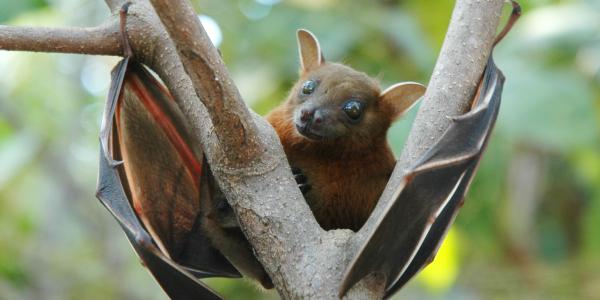
Joshua Blodgett, assistant professor of biology, knows that bats may not rank high on most people’s lists of lovable creatures. However, that has not stopped him from researching how to combat white-nose syndrome (WNS), an infectious disease that is wiping out bat populations across North America. WNS was first documented in 2007 when researchers in Schoharie County, New York observed bats with white fungal growth on their muzzles and ears. According to the U.S. Fish and Wildlife Service, WNS has been confirmed in bat hibernation sites in 31 states and five Canadian provinces.
The fungus (Pseudogymnoascus destructans or P. destructans) causes bats to experience incessant itching, which wakes them up when they should be hibernating. With their essential sleep disrupted, the bats end up displaying abnormal behavior, such as leaving their caves in the dead of winter. It is believed recreational cavers using gear contaminated with European cave material caused the onset of WNS in the United States.
So, why should the public care that these nocturnal and mysterious mammals are being eliminated at a rapid rate?
“Bats are keystone members of cave communities, and entire subterranean ecosystems may collapse without them,” says Blodgett.
A 2011 article published in Science estimated that bats provide up to $53 billion in crop protection because of their consumption of insect pests.
“Farmers will need to spend a lot more money on pesticides because bats have extraordinary value for agriculturally intensive parts of the country,” says Blodgett. “And that will eventually affect consumers in their pocket book.”

Blodgett, whose research career revolves around studying actinomycete bacteria, was curious if he could eliminate the white-nose fungus by using microbes adapted to living in caves. To do so, he would first need to sample cave soils and isolate as many actinomycetes as possible. The resulting bacteria would then have to be tested for their ability to produce bioactive small molecules. Actinomycetes are well-known antifungal producers, and particularly active strains might be used to kill off the fungus lurking in local caves.
By controlling P. destructans, Blodgett’s team hopes to break the seasonal disease cycle, protecting vulnerable bats. Funding to study WNS is not widespread, which is why Blodgett applied for and received a grant in 2016 from Washington University’s International Center for Energy, Environment and Sustainability (InCEES).
“InCEES is the hub for all matters related to energy, environment and sustainability at Washington University, and we’re dedicated to supporting diverse and collaborative research that is critical to the well-being of the planet,” said Himadri B. Pakrasi, the Myron and Sonya Glassberg/Albert and Blanche Greensfelder Distinguished University Professor and director of InCEES. “Part of our mission is to spur this kind of research through our pilot funding program. Josh’s project, which is a collaboration with Professor Tamara L. Doering from Washington University Medical School, is an example of a junior faculty member pursuing interdisciplinary innovations with real world impact. His findings will be important for Missouri and domestic agricultural production.”
To date, Blodgett’s lab has isolated more than 500 cave actinomycetes and has narrowed down roughly 20 different strains that selectively kill P. destructans.

“For this particular project, there are two critical factors that allowed us to begin our work,” says Blodgett. “First, is that InCEES funding exists. As a new faculty member, until you start publishing in an area, it is really hard to get traction. Secondly, is the fact that Tyson Research Center is part of Washington University and they have a wild cave on their site. Tyson is a good steward of the land, and they’re aware of the white-nose threat because it’s literally in their backyard.”
While Blodgett continues with the next steps in his research, he reiterates that finding a cure for WNS is urgently needed.
“This is not something that we can wait two decades and then see where we are,” says Blodgett. “It’s one of those areas that I truly believe scientific competition is wonderful. Frankly, who knows where the cure is going to come from. As scientists, all we can do at this point is document as many treatment options as possible. Then start working, hopefully, with government authorities to get field trials carried out. We urgently have to stem the tide.”





